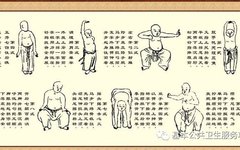The Eight Pieces of Brocade (Ba Duan Jin) is one of the classic traditional health-preserving practices in China, emphasizing the unity of body and mind, with a rich historical and cultural connotation. The Eight Pieces of Brocade consists of eight basic movements characterized by softness and slowness, fluidity and continuity, a combination of relaxation and tension, the integration of movement and stillness, the harmony of spirit and form, and the embodiment of qi (vital energy). The accompanying music for practice is light and soothing, capable of eliminating fatigue and regulating the mind.
The Eight Pieces of Brocade combines physical movement, breathing techniques, and psychological adjustment, effectively regulating the internal organs, promoting the circulation of qi and blood, unblocking the meridians, strengthening the muscles and bones, and calming the mind. Due to its simple movements and ease of mastery, it is classified as a low to moderate intensity aerobic exercise, with certain disease prevention and treatment effects, making it very popular among middle-aged and elderly individuals. In 2003, the General Administration of Sport of China restructured the Eight Pieces of Brocade and promoted it nationwide, with a complete set taking only twelve minutes to complete.
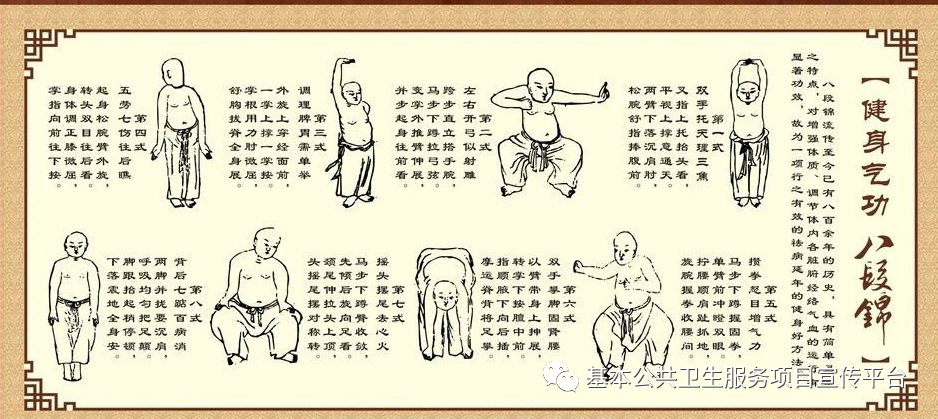
First Movement: Two Hands Hold Up the Heavens to Regulate the Triple Burner
The first movement, Two Hands Hold Up the Heavens to Regulate the Triple Burner, involves crossing both hands above the head while slightly bending the knees and squatting down, primarily achieving the fitness effect of distributing blood throughout the body.
Illustration of the Two Hands Hold Up the Heavens to Regulate the Triple Burner movement
Action One: From the previous position, rotate both arms outward and lower them slightly, crossing the palms in front of the abdomen with fingers spread apart, palms facing up; gaze forward (Figure 10).
Action Two: Continue the upward movement. Gradually straighten the knees; simultaneously, raise both palms to chest level, then rotate the arms inward and lift them up, palms facing up; lift the head and gaze at the palms (Figure 11).

Action Four: Gradually lower the body’s center of gravity; slightly bend the knees; simultaneously, slowly spread the fingers apart, lowering the arms to the sides, holding the palms in front of the abdomen, palms facing up; gaze forward. This movement is performed six times (Figure 13).
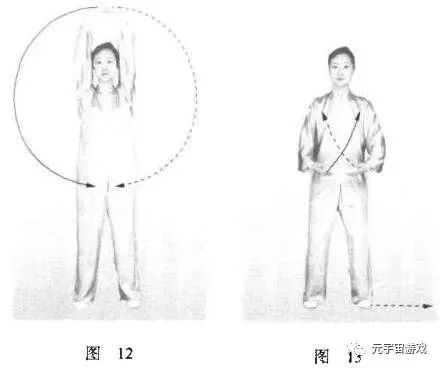
Second Movement: Drawing the Bow to Shoot the Hawk
The second movement, Drawing the Bow to Shoot the Hawk, involves bending the legs to form a horse stance while extending the arms alternately, with palms in a claw-like position, primarily aimed at expanding the chest and regulating the muscles, benefiting the lungs and heart.
Illustration of the Drawing the Bow to Shoot the Hawk movement
Action One: From the previous position, shift the body’s center of gravity to the right; step the left foot to the left side, keeping the knees straight; simultaneously, cross the palms at chest level, with the left palm on the outside, palms facing inward; gaze forward (Figure 14).
Action Two: Continue the upward movement. Gradually bend the knees into a horse stance; simultaneously, curl the right palm into a claw and pull it to shoulder height; the left palm forms a “八” shape, rotating inward and pushing to the left side at shoulder height, with the wrist bent, palm facing left, resembling the action of drawing a bow; pause slightly; gaze at the left palm (Figure 15).
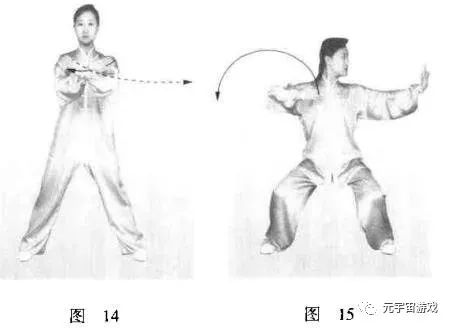
Action Three:Shift the body’s center of gravity to the right; simultaneously, extend the right hand with fingers spread, drawing an arc upward and to the right, at shoulder height, fingertips pointing up, palm angled forward; extend the left hand with fingers spread, palm angled backward; gaze at the right palm (Figure 16).
Action Four: Continue the upward movement. Shift the center of gravity further to the right; bring the left foot back to a standing position; simultaneously, lower both palms to the sides, holding them in front of the abdomen, fingertips facing each other, palms facing up; gaze forward (Figure 17).
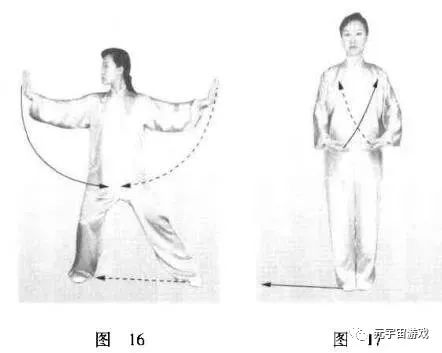
Actions Five to Eight: Repeat Actions One to Four, but in the opposite direction (Figures 18, 19, 20, 21).
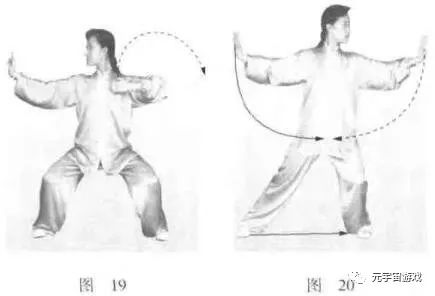
This movement is performed three times, alternating left and right.
At the end of the third round, continue shifting the center of gravity to the left; bring the right foot back to a horse stance, shoulder-width apart, with the knees slightly bent; simultaneously, lower both palms to the sides, holding them in front of the abdomen, fingertips facing each other, palms facing up; gaze forward (Figure 22).
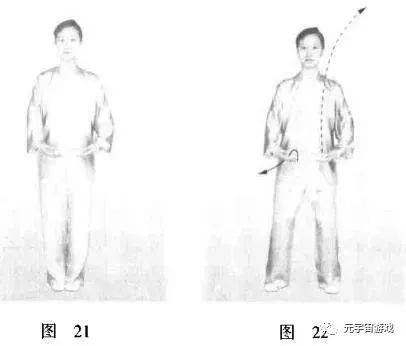
Third Movement: Regulating the Spleen and Stomach with One Hand Lift
The third movement, Regulating the Spleen and Stomach with One Hand Lift, involves alternating the hands to lift one at a time above the head while slightly bending the knees, achieving the purpose of stretching the meridians in Traditional Chinese Medicine (TCM) and thus regulating the spleen and stomach.
Illustration of the Regulating the Spleen and Stomach with One Hand Lift movement
Action One: From the previous position, gradually straighten the knees; simultaneously, lift the left palm, rotating the left arm outward and raising it above the head, with a slight bend in the elbow, applying force through the palm; palm facing up, fingers pointing right; simultaneously, slightly raise the right palm, rotating the right arm inward and pressing down to the right hip, with a slight bend in the elbow, applying force through the palm; palm facing down, fingers pointing forward, pausing slightly; gaze forward (Figure 23).
Action Two: Relax the waist and sink the hips, gradually lowering the body’s center of gravity; slightly bend the knees; simultaneously, bend the left arm outward, lowering the left palm in front of the abdomen, palm facing up; the right arm rotates outward, raising the right palm in front of the abdomen, with the fingertips facing each other, about 10 cm apart, palms facing up; gaze forward (Figure 24).
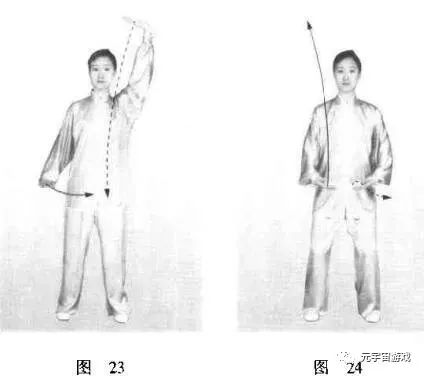
Actions Three and Four: Repeat Actions One and Two, but in the opposite direction (Figures 25, 26).
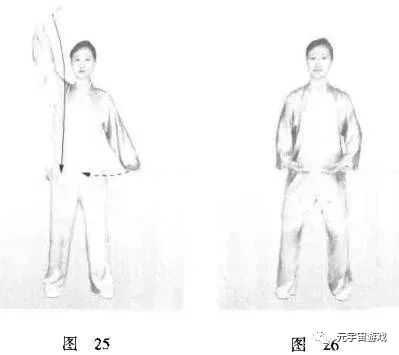
At the end of the third round, with the knees slightly bent; simultaneously, bend the right arm, pressing the right palm down to the right hip, palm facing down, fingers pointing forward, gaze forward (Figure 27).
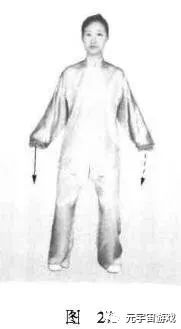
The fourth movement, Looking Back to Relieve Five Fatigues and Seven Injuries, involves standing while slightly bending the knees and slowly twisting the neck to the left and right, achieving the effect of relaxing the neck muscles and primarily preventing cervical spondylosis.
Illustration of the Looking Back to Relieve Five Fatigues and Seven Injuries movement
Action One: From the previous position, gradually straighten the knees; simultaneously, extend both arms straight, palms facing backward, fingertips pointing down, gaze forward (Figure 28). Then continue the upward movement. Fully rotate both arms outward, palms facing outward; turn the head to the left and pause slightly; gaze at the left diagonal back (Figure 29).
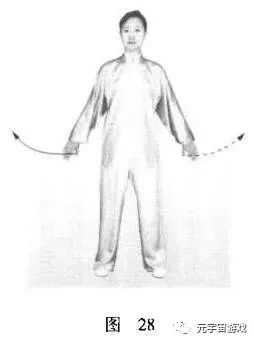
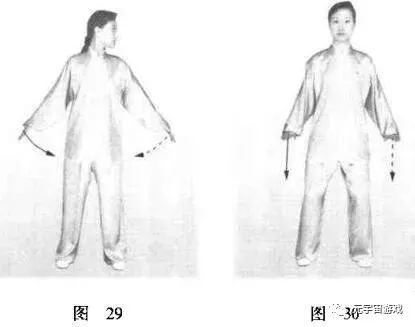
Action Two: Relax the waist and sink the hips, gradually lowering the body’s center of gravity; slightly bend the knees; simultaneously, rotate both arms inward to the hips, palms facing down, fingertips pointing forward; gaze forward (Figure 30).
Action Three: Repeat Action One, but in the opposite direction (Figures 31, 32).
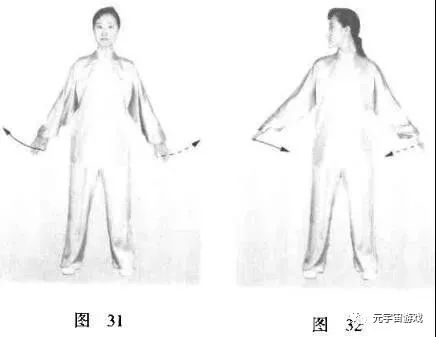
Action Four: Repeat Action Two (Figure 33).
At the end of the third round, with the knees slightly bent; simultaneously, hold both palms in front of the abdomen, fingertips facing each other, palms facing up; gaze forward (Figure 34).
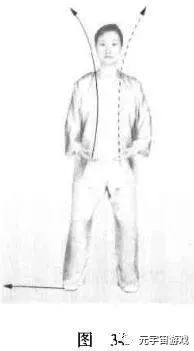
The fifth movement, Shaking the Head and Wagging the Tail to Eliminate Heart Fire, involves a fixed horse stance while shaking the upper body and head, achieving simultaneous exercise of the waist, spine, and neck, thus preventing cervical spondylosis and promoting fitness.
Illustration of the Shaking the Head and Wagging the Tail to Eliminate Heart Fire movement
Action One: From the previous position, shift the body’s center of gravity to the left; step the right foot to the right side, keeping the knees straight; simultaneously, raise both palms to chest level, with the arms rotating inward, continuing to lift the palms above the head, with a slight bend in the elbows, palms facing up, fingertips facing each other; gaze forward (Figure 35).
Action Two: Continue the upward movement. Gradually bend the knees into a horse stance; simultaneously, lower both arms to the sides, placing the palms above the knees, with a slight bend in the elbows, little fingers facing forward; gaze forward (Figure 36).
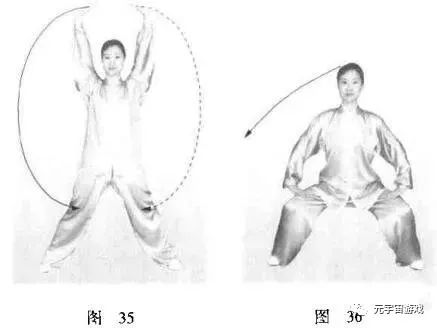
Action Three: The body’s center of gravity rises slightly, then shifts to the right; the upper body leans to the right, then bends forward; gaze at the right foot (Figure 37).
Action Four: Continue the upward movement. Shift the body’s center of gravity to the left; simultaneously, rotate the upper body from right to left; gaze forward (Figure 38).
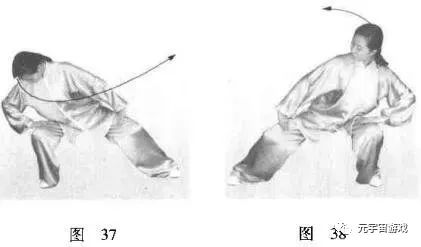
Action Five: Shift the body’s center of gravity to the right, forming a horse stance; simultaneously, shake the head back, raising the upper body, then slightly retract the chin; gaze forward (Figure 39).
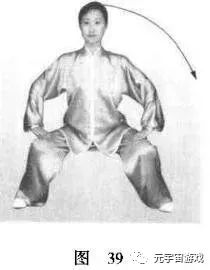
Actions Six to Eight: Repeat Actions Three to Five, but in the opposite direction (Figures 40, 41, 42).
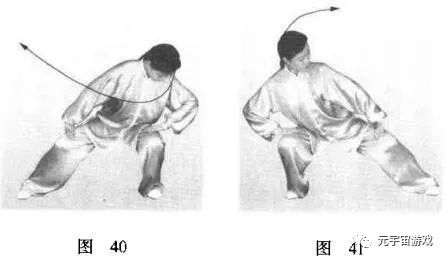
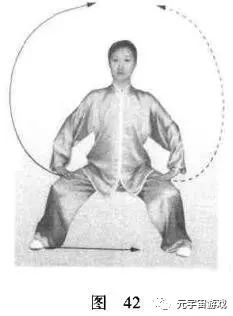
After completing three rounds, shift the body’s center of gravity to the left, bringing the right foot back to a horse stance, shoulder-width apart; simultaneously, raise both palms outward, palms facing each other; gaze forward (Figure 43). Then relax the waist and sink the hips, gradually lowering the body’s center of gravity. Slightly bend the knees; simultaneously, bend the elbows, pressing both palms down to the abdomen, palms facing down, fingertips facing each other; gaze forward (Figure 44).
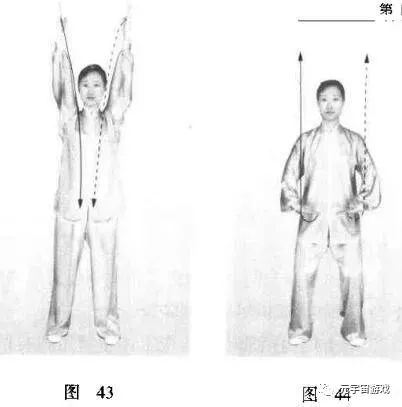
The sixth movement, Two Hands Grasping the Feet to Strengthen the Kidneys and Lower Back, involves bending at the waist to place both hands on the feet, thus exercising the lower back while simultaneously massaging the kidneys, enhancing kidney energy.
Illustration of the Two Hands Grasping the Feet to Strengthen the Kidneys and Lower Back movement
Action One: From the previous position, stand with straight legs; simultaneously, extend both arms forward and upward, with elbows straight, palms facing forward; gaze forward (Figure 45).
Action Two: Rotate both arms outward until the palms face each other, bending the elbows, pressing the palms down to the chest, palms facing down, fingertips facing each other; gaze forward (Figure 46).
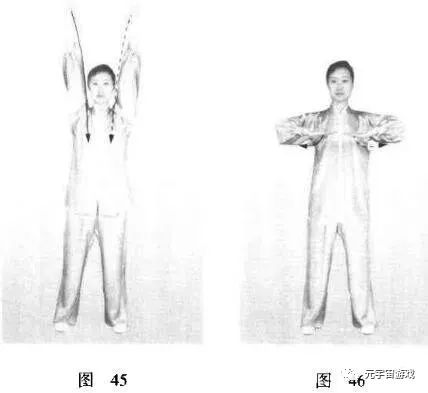
Action Three: Continue the upward movement. Rotate both arms outward, palms facing up, then insert the palms under the armpits; gaze forward (Figure 47).
Action Four: With palms facing inward, slide down along both sides of the spine to the hips; then bend forward, continuing to slide down the legs to the feet; lift the head, pausing slightly; gaze downward (Figure 48).
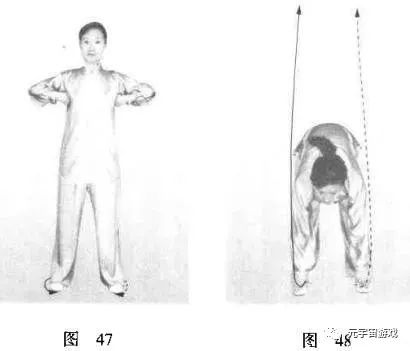
After completing six rounds, stand upright; simultaneously, raise both arms forward and upward, with elbows straight, palms facing forward; gaze forward (Figure 49). Then relax the waist and sink the hips, gradually lowering the body’s center of gravity; slightly bend the knees; simultaneously, press both palms down to the abdomen, palms facing down, fingertips facing forward; gaze forward (Figure 50).
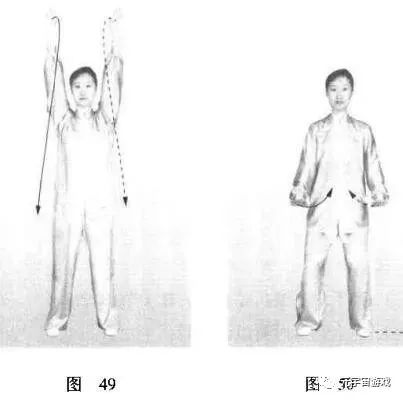
Seventh Movement: Clenching the Fist and Glaring to Increase Strength
The seventh movement, Clenching the Fist and Glaring to Increase Strength, involves clenching the fists to enhance strength, similar to the horse stance in martial arts, but this movement is more focused on health preservation.
Illustration of the Clenching the Fist and Glaring to Increase Strength movement
From the previous position, shift the body’s center of gravity to the right, stepping the left foot to the left; gradually bend the knees into a horse stance; simultaneously, clench both palms at the waist, with the fist openings facing up; gaze forward (Figure 51).
Action One: Slowly thrust the left fist forward to shoulder height, with the fist opening facing up; glare, focusing on the direction of the left fist (Figure 52).
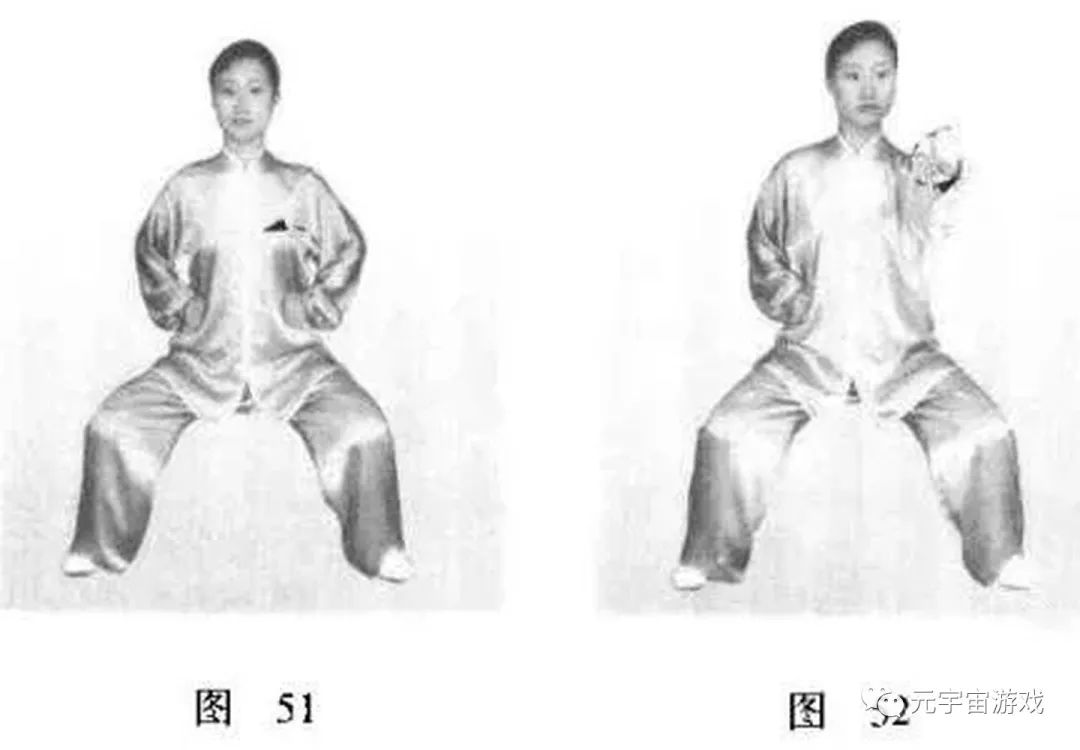
Action Two: Rotate the left arm inward, transforming the left fist into a palm, with the tiger mouth facing down; gaze at the left palm (Figure 53). Rotate the left arm outward, with a slight bend in the elbow; simultaneously, wrap the left palm around, turning the palm upward; gaze at the left fist (Figure 54).
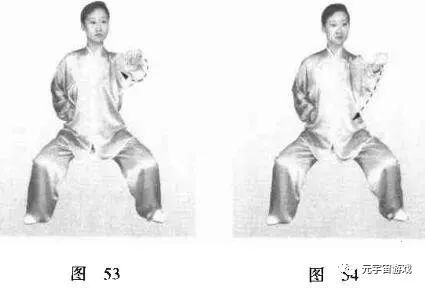
Action Three: Bend the elbow, retract the left fist to the waist, with the fist opening facing up; gaze forward (Figure 55).
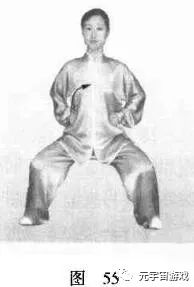
Actions Four to Six: Repeat Actions One to Three, but in the opposite direction (Figures 56, 57, 58, 59).
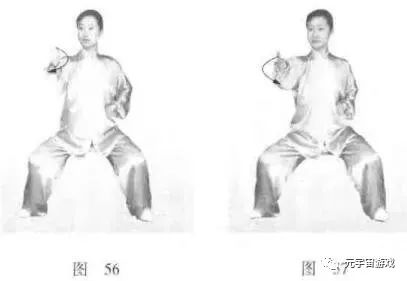
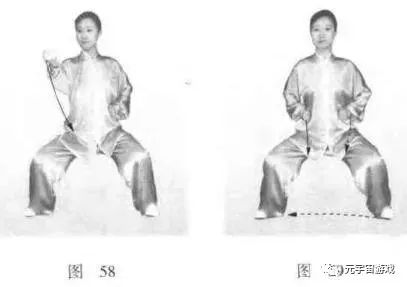
After completing three rounds, shift the body’s center of gravity to the right, bringing the left foot back to a standing position; simultaneously, transform both palms into fists, letting them hang naturally at the sides; gaze forward (Figure 60).
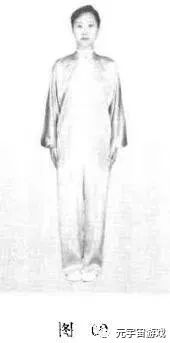
The eighth movement, Seven Bounces Behind to Eliminate All Illnesses, involves bouncing on the heels seven times to achieve the effect of eliminating all diseases. This action vibrates the entire spine, invigorating the spirit.
Illustration of the Seven Bounces Behind to Eliminate All Illnesses movement
Action One: From the previous position, lift both heels; hold the head up, pausing slightly; gaze forward (Figure 61).
Action Two: Lower the heels, lightly shaking the ground; gaze forward (Figure 62).
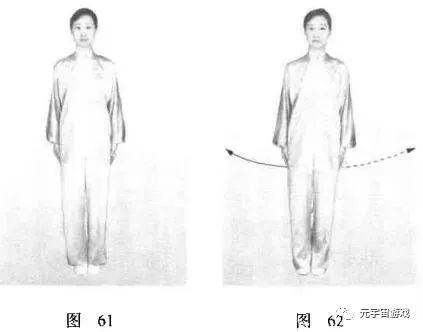
Song of the Eight Pieces of BrocadeTwo Hands Hold Up the Heavens to Regulate the Triple Burner;Drawing the Bow to Shoot the Hawk;Regulating the Spleen and Stomach with One Hand Lift;Looking Back to Relieve Five Fatigues and Seven Injuries;Clenching the Fist and Glaring to Increase Strength;Two Hands Grasping the Feet to Strengthen the Kidneys and Lower Back;Shaking the Head and Wagging the Tail to Eliminate Heart Fire;Seven Bounces Behind to Eliminate All Illnesses.
The Eight Pieces of Brocade, compiled by the General Administration of Sport of China. Images are sourced from the official Weibo account of the People’s Daily.

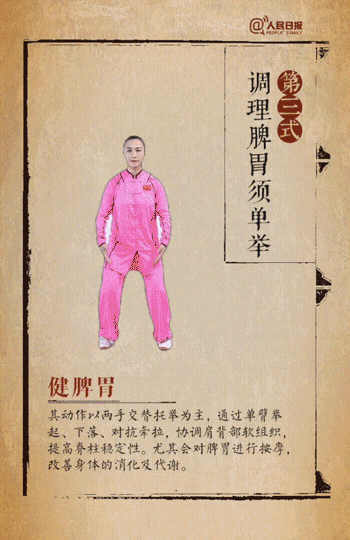
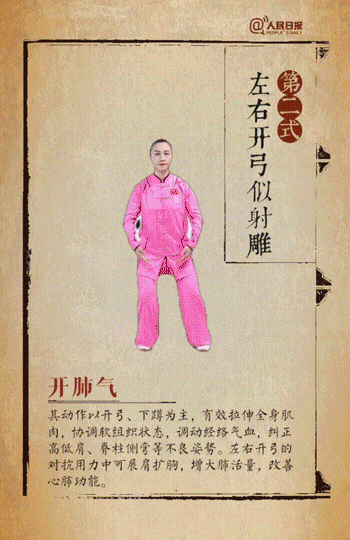
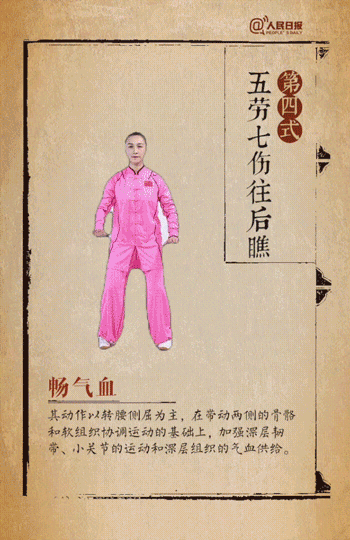
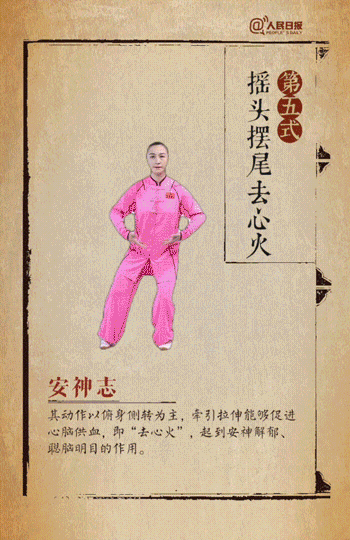
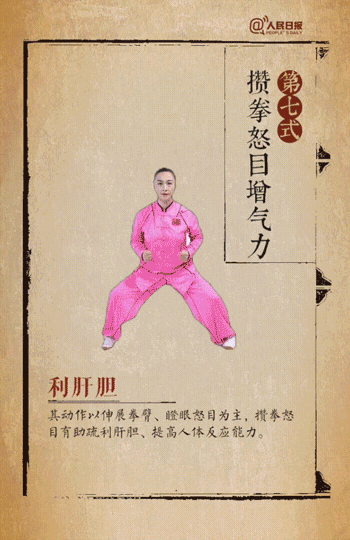
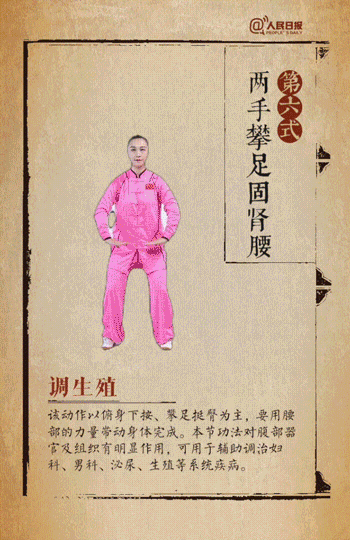
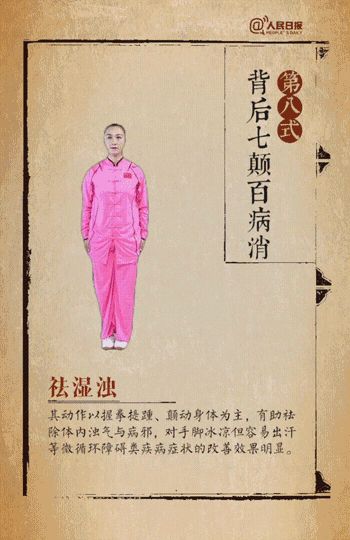
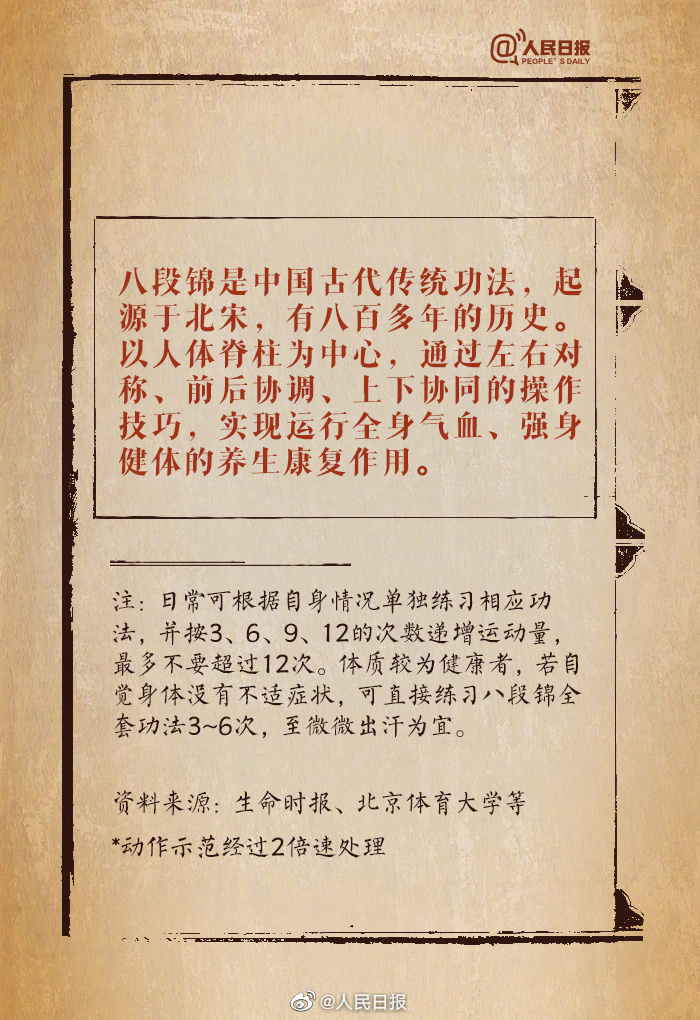
Source: Basic Public Health Service Project Promotion Platform
If there is any infringement, please contact for deletion, thank you!

